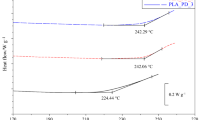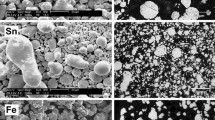Abstract
The influence of metallization time on thermal stability of copper-plated polylactide (PLA) has been presented. The tests of oxidation onset temperature (OOT) and thermogravimetric analysis (TG) of metallized samples have been performed. Studies have shown that in the case of OOT, effect of metallization time is most pronounced for samples with a highly modified surface. This is due to an increase in contact area between the PLA and copper layer, leading to an increase in the catalytic activity of copper atoms relative to the oxidation process. In TG studies, the greatest effect of metallization time was observed for samples with the least modified surface. Observed effect is related to the variation in thickness of the deposited copper. Low heat capacity and a good thermal conductivity of copper lead to faster heating of the deposited layer, improve the heat transfer to the polymer bulk and thus faster increase in its temperature resulting in lowering of thermal stability.





Similar content being viewed by others
References
Auras R, Lim L-T, Selke SEM, Tsuji H, editors. Poly(lactic acid). Synthesis, structures, properties, processing, and applications. Hoboken: Wiley; 2010.
Murariu M, Dubois P. PLA composites: from production to properties. Adv Drug Deliv Rev. 2016;107:17–46.
Castro-Aguirre E, Iñiguez-Franco F, Samsudin H, Fang X, Auras R. Poly(lactic acid)—mass production, processing, industrial applications and end of life. Adv Drug Deliv Rev. 2016;107:333–66.
Nampoothiri KM, Nair NR, John RP. An overview of the recent developments in polylactide (PLA) research. Bioresour Technol. 2010;101:8493–501.
Phetwarotai W, Aht-Ong D. Isothermal crystallization behaviors and kinetics of nucleated polylactide/poly(butylene adipate-co-terephthalate) blend films with talc. J Therm Anal Calorim. 2016;126:1797–808.
Rytlewski P, Mróz W, Budner B, Moraczewski K, Malinowski R, Jagodziński B. Application of thermogravimetry in the assessment of coatings ability to be metallized. J Therm Anal Calorim. 2017;127:381–7.
Vidović E, Faraguna F, Jukić A. Influence of inorganic fillers on PLA crystallinity and thermal properties. J Therm Anal Calorim. 2017;127:371–80.
Saad GR, Elsawy MA, Aziz MSA. Nonisothermal crystallization behavior and molecular dynamics of poly(lactic acid) plasticized with jojoba oil. J Therm Anal Calorim. 2017;128:211–23.
Tiganis BE, Burn LS, Davis P, Hill AJ. Thermal degradation of acrylonitrile butadiene–styrene (ABS) blends. Polym Degrad Stab. 2002;76:425–34.
Tavares AC, Gulmine JV, Lepienski CM, Akcelrud L. The effect of accelerated aging on the surface mechanical properties of polyethylene. Polym Degrad Stab. 2003;81:367–73.
Santonja-Blasco L, Ribes-Greus A, Alamo RG. Comparative thermal, biological and photodegradation kinetics of polylactide and effect on crystallization rates. Polym Degrad Stab. 2013;98:771–84.
Fukushima K, Tabuani D, Arena M, Gennari M, Camino G. Effect of clay type and loading on thermal, mechanical properties and biodegradation of poly(lactic acid) nanocomposites. React Funct Polym. 2013;73(3):540–9.
Yeon MJ, Ryu J, Ko JH, Yoon JS. Hydrolysis and thermal degradation of poly(l-lactide) in the presence of talc and modified talc. J Appl Polym Sci. 2013;129:1019–25.
Liu Y, Chen W, Kim H. Synthesis, characterization, and hydrolytic degradation of polylactide/poly(ethylene glycol)/nano-silica composite films. J Macromol Sci Part A Pure Appl Chem. 2012;49(4):348–54.
Ndazi BS, Karlsson S. Characterization of hydrolytic degradation of polylactic acid/rice hulls composites in water at different temperatures. Express Polym Lett. 2011;5(2):119–31.
Olewnik-Kruszkowska E. Influence of the type of buffer solution on thermal and structural properties of polylactide-based composites. Polym Degrad Stab. 2016;129:87–95.
Deroine M, Duigou AL, Corre YM, Gac YML, Davies P, Cesar G, Bruzaud S. Accelerated aging of polylactide in aqueous environments: comparative study between distilled water and seawater. Polym Degrad Stab. 2014;108:319–29.
Kaya H, Özdemir E, Kaynak C, Hacaloglu J. Effects of nanoparticles on thermal degradation of polylactide/aluminium diethylphosphinate composites. J Anal Appl Pyrolysis. 2016;118:115–22.
Kaya H, Hacaloglu J. Thermal degradation of polylactide/aluminium diethylphosphinate. J Anal Appl Pyrolysis. 2014;110:155–62.
Chen BK, Shih CC, Chen AF. Ductile PLA nanocomposites with improved thermal stability. Compos A. 2012;43:2289–95.
Lizundia E, Vilas JL, León LM. Crystallization, structural relaxation and thermal degradation in poly(l-lactide)/cellulose nanocrystal renewable nanocomposites. Carbohydr Polym. 2015;123:256–65.
Márquez Y, Franco L, Puiggalí J. Thermal degradation studies of poly(trimethylene carbonate) blends with either polylactide or polycaprolactone. Thermochim Acta. 2012;550:65–75.
Zweifel H, Maier RD, Schiller M. Plastics additives handbook. München: Carl Hanser; 2009.
Schramm R, Reinhardt A, Franke J. Capability of biopolymers in electronics manufacturing. In: 35th International Spring Seminar on Electronics Technology (ISSE), Bad Aussee, Austria; 2012.
Moroi G. Influence of ion species on the thermal degradation of polyurethane interaction products with transition metal ions. J Anal Appl Pyrolysis. 2004;71(2):485–500.
Chiu SJ, Cheng WH. Promotional effect of copper(II) chloride on the thermal degradation of poly(ethylene terephthalate). J Anal Appl Pyrolysis. 2000;56:131–43.
Gorghiu LM, Jipa S, Zaharescu T, Setnescu R, Mihalcea I. The effect of metals on thermal degradation of polyethylenes. Polym Degrad Stab. 2004;84:7–11.
Moraczewski K, Rytlewski P, Malinowski R, Tracz A, Żenkiewicz M. Influence of DC plasma modification on the selected properties and the geometrical surface structure of polylactide prior to autocatalytic metallization. Mater Chem Phys. 2015;153:135–44.
Moraczewski K, Malinowski R, Rytlewski P, Żenkiewicz M. Autocatalytic metallization of polylactide. Polimery. 2015;60(7–8):492–501.
Moraczewski K, Mróz W, Budner B, Żenkiewicz M. Laser modification of polylactide surface layer prior autocatalytic metallization. Surf Coat Technol. 2016;304:68–75.
Yang J, Wan YQ, Wang SG, Tu CF, Cai Q, Bei JZ. Enhancing the cell affinity of macroporous poly(l-lactide) cell scaffold by a convenient surface modification method. Polym Int. 2003;52:1892–9.
ISO 11357-6. Plastics; Differential scanning calorimetry (DSC); Part 6: determination of oxidation induction time (isothermal OIT) and oxidation induction temperature (dynamic OIT). Geneva: International Organization for Standardization; 2008.
ISO 11358-1:2014. Plastics—thermogravimetry (TG) of polymers; Part 1: general principles. Geneva: International Organization for Standardization; 2014.
Acknowledgements
The project has been financed from the funds of the National Science Centre allocated upon Decision Number DEC-2011/01/N/ST8/04397.
Author information
Authors and Affiliations
Corresponding author
Rights and permissions
About this article
Cite this article
Moraczewski, K. Effect of metallization time on thermal stability of copper-plated polylactide. J Therm Anal Calorim 129, 1697–1703 (2017). https://doi.org/10.1007/s10973-017-6382-5
Received:
Accepted:
Published:
Issue Date:
DOI: https://doi.org/10.1007/s10973-017-6382-5




